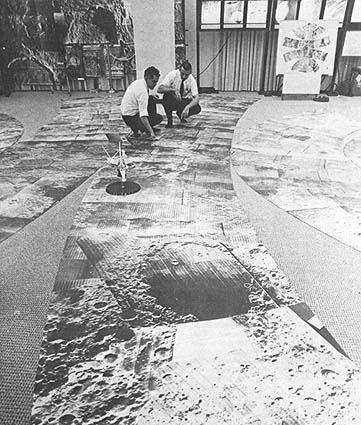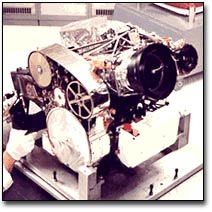|
The NASA Lunar Photos |
|
|
Where Did all the Big Photos Go? .
The image above shows NASA scientists studying the high
resolution large images on the floor laid out in a mosaic. It is interesting
to note that even in this photo we have an anomaly. The area next to Mare
Crissium, an area that has been a source of enigmas for decades is conspicuously
white. The set above is from Lunar Orbiter IV
Excerpt: ORBITER IV "The prime objective of Lunar Orbiter IV," wrote JAMES S. MARTIN, Deputy Lunar Orbiter Project Manager, Langley Research Center, NASA, "was to photograph the entire front side of the Moon at a resolution considerably better than is possible from Earth. The mosaic on the opposite page is the result. The pictures, taken May 11-25, 1967, span an area from the North Pole (at top) to the South Pole, and from the eastern limb (at right) to the western limb. "The complete mosaic is approximately 40 by 45 feet. It was laid on the floor, and observers were allowed to stand on it or crawl over it in their stocking feet. Some astronomers chose the latter course, carrying magnifying glasses. The mosaic was a primary source in selecting scientific sites for Lunar Orbiter V to photograph at higher resolutions." - SOURCE: NASA History |
|
|
ITT Space Systems Division .
Excerpt One: Image Capture—How The System Worked "Once on orbit above the Moon's sunlit side, each Orbiter took pictures via the photographic system's 610 mm high-resolution lens, and via an 80 mm wide-angle medium-resolution lens. Both lenses placed their frame exposures on a single roll of 70 mm film. During exposure, the system moved the film to prevent image blur as the lunar surface sped by below. On a typical Lunar Orbiter mission, the photographic system provided high-resolution pictures of 4,000 square miles of the Moon's surface with enough clarity to show objects the size of a card table. At the same time, medium-resolution photographs covering 20,000 square miles could be made with overlap for stereo viewing and analysis of surface topography. Photos were processed automatically by the Orbiter's photographic system as the spacecraft orbited the Moon's dark side. This operation was performed by a KODAK BITMAT diffusion transfer process using 'dry' chemistry. A high-intensity light beam then optically scanned the photographic prints, and the images were transmitted to receiving stations on Earth. The 1600 pictures captured in total by the five Lunar Orbiters using the ITT photographic system enabled photogrammetrists at NASA and the U.S. Government's Defense Mapping Agency to create accurate maps of the Moon's surface. From these photos, maps, and other lunar data, NASA identified the Sea of Tranquillity as the final landing site for the Apollo 11 mission in 1969." - SOURCE: ITT Excerpt Two: About the Lunar Orbiter missions "Launched in 1966 and 1967, all five missions Lunar Orbiter were successful. The missions collectively photographed 99% of the Moon's surface with a resolution of 60 m ground resolution or better. The first three missions, dedicated to imaging 20 potential Apollo landing sites, were flown at near equatorial orbits as close as 22 miles above the lunar surface. The fourth and fifth missions were devoted to broader scientific objectives, and were flown in high altitude polar orbits." - SOURCE: ITT |
|
| So where are those 1600 pictures captured that photographed 99% of the Moon's surface from orbits as close as 22 miles above the lunar surface? We have been looking to NASA to find the high resolution images. Perhaps we should be asking the U.S. Government's Defense Mapping Agency | |
|
My Story of dealing with NASA in the 1970's
Excerpt:
To read this very interesting article see here: My Story of dealing with NASA in the 1970's - by Vito Saccheri Witness Says NASA Photos Show Structures on Moon - CNI News Investigators, Though Cautious, Say Photos Show Anomalies - by Lan Fleming NASA Employed Photo Artists To Airbrush Out Apollo Anomalies! |
|
| FAIR USE NOTICE: This page contains copyrighted material the use of which has not been specifically authorized by the copyright owner. Pegasus Research Consortium distributes this material without profit to those who have expressed a prior interest in receiving the included information for research and educational purposes. We believe this constitutes a fair use of any such copyrighted material as provided for in 17 U.S.C § 107. If you wish to use copyrighted material from this site for purposes of your own that go beyond fair use, you must obtain permission from the copyright owner. | |
|
|


